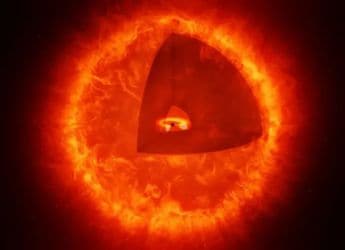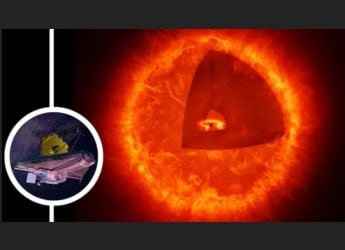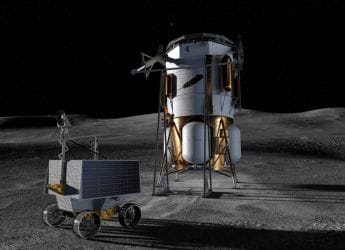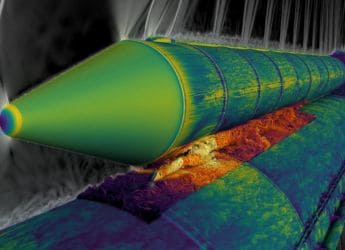- Home
- Science
- Science News
- Tiny Red Dots Spotted By NASA’s James Webb Telescope Could Be Black Hole Stars
Tiny Red Dots Spotted By NASA’s James Webb Telescope Could Be Black Hole Stars
Astronomers studying JWST’s puzzling “little red dots” propose they may be vast gas spheres powered by feeding black holes.

Photo Credit: Max Planck Institute for Astronomy
James Webb spots mysterious little red dots, likely elusive black hole stars
Tiny red specks spotted by NASA's James Webb Space Telescope (JWST) have puzzled astronomers since 2022. These “little red dots” appear far more mature and luminous than expected at such an early time, leading some to dub them “universe breakers”. A new study offers an alternative: the dots might be single enormous spheres of gas surrounding voracious black holes – a novel kind of “black hole star”. If correct, this could explain how supermassive black holes grew so rapidly in the universe's infancy.
Recent Observations
According to the research in the journal Astronomy & Astrophysics, a research group under the direction of astrophysicist Joel Leja investigated these dots in 2024 using JWST's spectrographs. They gathered spectra from roughly 4,500 far-off galaxies over the course of 60 hours. One item, known as "The Cliff," stood out. Its spectrum suggested that the light originated from a single massive source rather than a group of stars, and it was located about 12 billion light-years away. Subsequent investigation revealed that the Cliff's light was consistent with that of a supermassive black hole that is covered in a cloud of hydrogen and feeds on gas.
Emerging Debates
Each dot is effectively a single giant, cold gas "star" driven by a voracious black hole, according to the black-hole-star model. Rather than a swarm of stars, Leja characterises it as "one gigantic, very cold star." However, this notion is still hypothetical. Different explanations are preferred by other astronomers. Pacucci and Loeb, for instance, propose that the dots might just be compact infant galaxies that are forming in infrequent, slow-spinning dark-matter halos, with dust or dense stars providing the red glow. Researchers stress that additional JWST observations are required to determine the best explanation.
For the latest tech news and reviews, follow Gadgets 360 on X, Facebook, WhatsApp, Threads and Google News. For the latest videos on gadgets and tech, subscribe to our YouTube channel. If you want to know everything about top influencers, follow our in-house Who'sThat360 on Instagram and YouTube.
Related Stories
- Samsung Galaxy Unpacked 2025
- ChatGPT
- Redmi Note 14 Pro+
- iPhone 16
- Apple Vision Pro
- Oneplus 12
- OnePlus Nord CE 3 Lite 5G
- iPhone 13
- Xiaomi 14 Pro
- Oppo Find N3
- Tecno Spark Go (2023)
- Realme V30
- Best Phones Under 25000
- Samsung Galaxy S24 Series
- Cryptocurrency
- iQoo 12
- Samsung Galaxy S24 Ultra
- Giottus
- Samsung Galaxy Z Flip 5
- Apple 'Scary Fast'
- Housefull 5
- GoPro Hero 12 Black Review
- Invincible Season 2
- JioGlass
- HD Ready TV
- Laptop Under 50000
- Smartwatch Under 10000
- Latest Mobile Phones
- Compare Phones
- Xiaomi 17
- Xiaomi 17 Pro Max
- Xiaomi 17 Pro
- Xiaomi 15T Pro
- Xiaomi 15T
- OPPO A6 Pro 4G
- Vivo V60 Lite 5G
- Samsung Galaxy A17 4G
- HP OmniBook X Flip 14 (B91BSPA)
- Acer Nitro V 16S (2025)
- Xiaomi Pad 8
- Xiaomi Xiaomi Pad 8 Pro
- Xiaomi Smart Band 10 Glimmer Edition
- Xiaomi Watch S4 41mm
- Xiaomi Xiaomi TV S Pro Mini LED 55 2026
- Xiaomi TV S Pro Mini LED 65 2026
- Asus ROG Ally
- Nintendo Switch Lite
- Haier 1.6 Ton 5 Star Inverter Split AC (HSU19G-MZAID5BN-INV)
- Haier 1.6 Ton 5 Star Inverter Split AC (HSU19G-MZAIM5BN-INV)

















